A well maintained Corsair 36' folding trimaran for sale in the middle of the Netherlands
- Location :
- Gelderland, Netherlands
- Year :
- 2003
It’s back to the Atlantic for Jangada and her crew, navigating along the dunes of the Namib Desert! This long line of sand dunes stretches for almost 1,300 miles (2,000 km), from South Africa to Angola. Seen from the shore, this Namibian coastal desert seems desolate and inhospitable. But some semidesert regions in the interior of the country offer fabulous landscapes.
We leave the bay of Saldanha under sail, heading north. We were leaving South Africa, accompanied by the seals and cormorants that love the cold waters along the western coast of the south of the continent. In this region, one actor plays the starring role: the cold Benguela Current. Its waters have their origins in the icy Antarctic Ocean and they meet the warm waters of the Agulhas Current (coming from the tropical Indian Ocean) on the South African continental shelf. This zone where different currents meet, and which often witnesses dramatic weather, is rich in nutrients and favors the development of marine flora and fauna. These upwellings (where cold water makes its way to the surface) provide more than 40 % of the catch of the world’s fisheries, although they represent less than 3 % of the surface of the oceans! The upwellings which develop along the Namibian coast are due to the permanent action of the trade winds on the surface of the South Atlantic Ocean. This vertical oceanic gyratory movement on the continental shelves located to the east of the oceans promotes the upwelling of cold deep waters loaded with highly nutritious mineral salts. The intense planktonic life that develops thanks to these favorable conditions is responsible for the existence of a very active food chain in these regions.
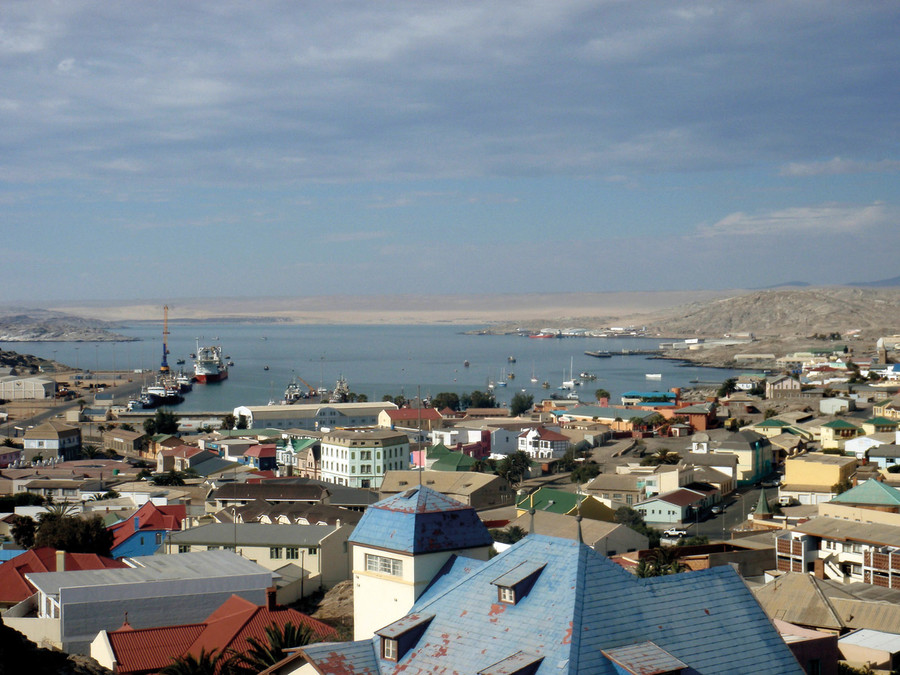
The port of Lüderitz manages to keep a nostalgic and fading city alive.
Fog and Foghorns…
The crew of our modest cruising catamaran, en route to Lüderitz, quickly checked some of the practical consequences of the conditions detailed above. The temperature of the sea water had dropped to 55°F (13°C). When the hot desert air meets the cold surface water, the effect is immediate: the drop in the dew point causes a thick fog that covers the sea and envelops everything that sails on it! Visibility was reduced to a few feet, with relative humidity exceeding 100%. You have to move forward cautiously, with your eyes riveted on the radar screen. Large banks of seaweed (kelp), sometimes more than 30 feet long, bobbed on the surface of the water, threatening our propellers. We sailed among seals, and it was not uncommon to see several dozens of them at the same time. Dolphins were also numerous, and we would occasionally cross the erratic paths of small penguins coming up for air between dives. Black cormorants were legion, as well as gannets, pelicans and seagulls. Another consequence of these particular conditions is that as soon as the night wraps you in a second cocoon, the boat’s passage through the sea is accompanied by a breathtaking display of phosphorescent particles due to the abundance of plankton. It was like something from a fairy tale. In the wake of the two hulls of our catamaran, these natural fireworks form a permanent display. One night, while we were progressing downwind under sail at 9 or 10 knots, I woke Marin up from his sleep in the saloon so that he could witness this incredible natural spectacle: the effect of the thousands of luminous particles around the bows and which then disappear far off in our wake, combined with the crests of the waves breaking around the boat, gave us the impression of sailing at high speed in the middle of many luminescent breakers, leading us straight towards a terrible and fatal disaster... It was only an illusion, but what a spectacle!
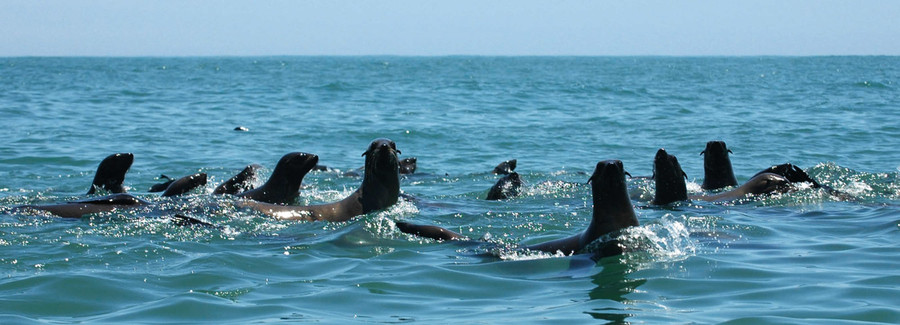
There are lots of fur seal colonies along the Namibian coast.
Diamonds: fortune and misfortune
We hugged the coastline and let the sinister and desolate looking lighthouse of Diaz Point pass behind us. At anchor in the bay of Lüderitz, we discovered some strange boats with dense and complicated superstructures: the «diamond diggers». Some are more than 650 feet (200 meters) long. They track down the precious ore at the bottom of the sea, on the Namibian continental shelf. Some other, much smaller boats moored on concrete platforms are also equipped with an underwater suction system: they too are seeking their fortune, but this time in shallow waters, inaccessible to the larger vessels, which buy their finds from them. Lüderitz, a small port town in serious decline, is located in one of the few inlets along the very straight coast of the Namib Desert. Further north, there is also Spencer Bay, Sandwich Harbour, or Walvis Bay. This area where the diamond deposits are located is highly regulated. And very well guarded. Access is forbidden to the entire Sperrgebiet, a huge coastal area that runs from about 50 mi (80 km) north of Lüderitz to Oranjemund, about 150mi (250 km) south, on the South African border. This no-go zone also extends out to sea, all along the coast, to the 65-fathom (120-meter) contour line. The area is considered to be one of the world’s leading diamond producing areas. Stepping on a diamond is exactly what happened in 1908 to August Stauch, an employee of one of the world’s most remote railroad lines. Earlier, Adolf Lüderitz, a German trader, had concluded a treaty with the local indigenous population of the Namas in 1883, by which he appropriated all the land around the bay. The Germans had arrived in Namibia at that time to establish a colony: Südwestafrika. Lüderitz had no idea that he had stumbled upon a treasure. He was only thinking of mining guano, which was considered «white gold» in those days, and which was abundant on the coast and on the islets where thousands of seabirds had been living for centuries. This was enough for his trading post to survive financially. Seven years after Stauch’s discovery, Südwestafrika had produced several million carats of diamonds! Lüderitz experienced a boom. Hotels sprang up from the sand, Germanic style villas were built thanks to the new fortunes that had been made. Bowling alleys, clubs and a casino were built. Sailors abandoned their ships and guano collectors left their islands to seek their fortune in the desert. After World War I, the economic recession hit the diamond industry hard. Later still, discoveries were concentrated more in the southern part of the Sperrgebiet. The mining town of Kolmanskop, located about 6 miles (10 km) from Lüderitz in the interior of the desert, was finally abandoned in 1956. Since then, the desert sands have taken over the town again in eerie fashion. Lüderitz nowadays scrapes a living, mainly from its port, which serves as a base for diamondseeking ships and fishermen from the cold waters of the Benguela Current. On the outside, the large buildings have retained their former splendor, and the Germanic aspect of the small city, dominated by its Lutheran church, stands proudly today on the edge of the Namib desert.
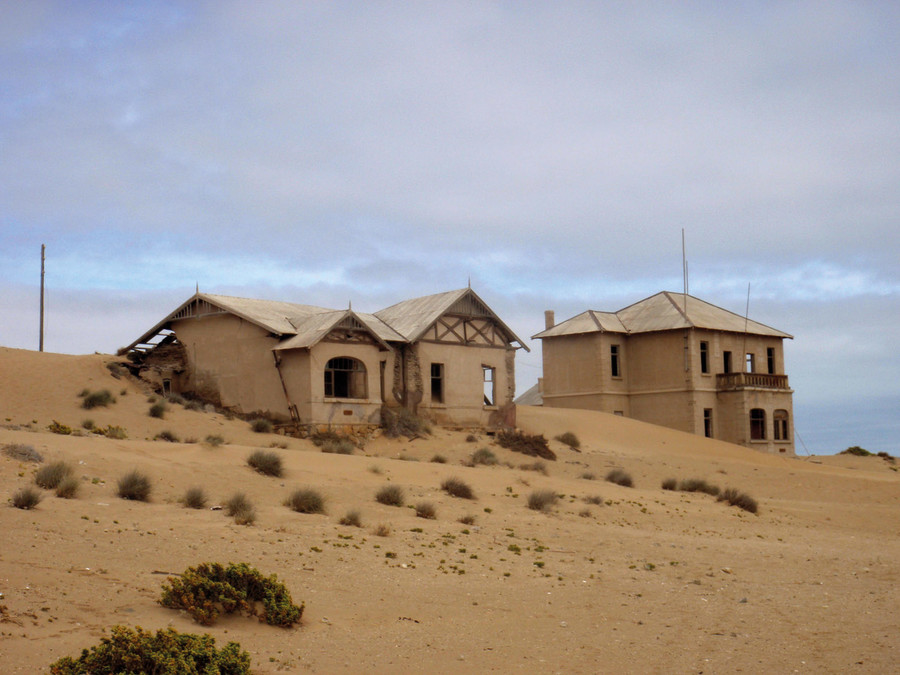
The mining town of Kolmanskop, near Lüderitz, has been slowly taken over by the desert sands for decades.
Wild Namibia
Leaving Lüderitz with a rental car, we drove up the Oranje River, before heading to the famous Fish River Canyon and then on to the small village of Maltahöhe. Then we took the C14, a gravel road that goes down to Aus, through fabulous landscapes. If one day you find yourself in this region, I recommend that you take the C13 between Hemerinhausen and Aus, at the end of the afternoon, when the warm light of the sunset illuminates the vast expanses of the Neisipvlakte Plains with the most incredible colors. What magnificent landscapes! They are populated by gemsbok, kudu, springbok and ostrich, with a few scattered farms that can be spotted from afar with their ancestral windmills, used to keep the animals’ watering troughs topped up.
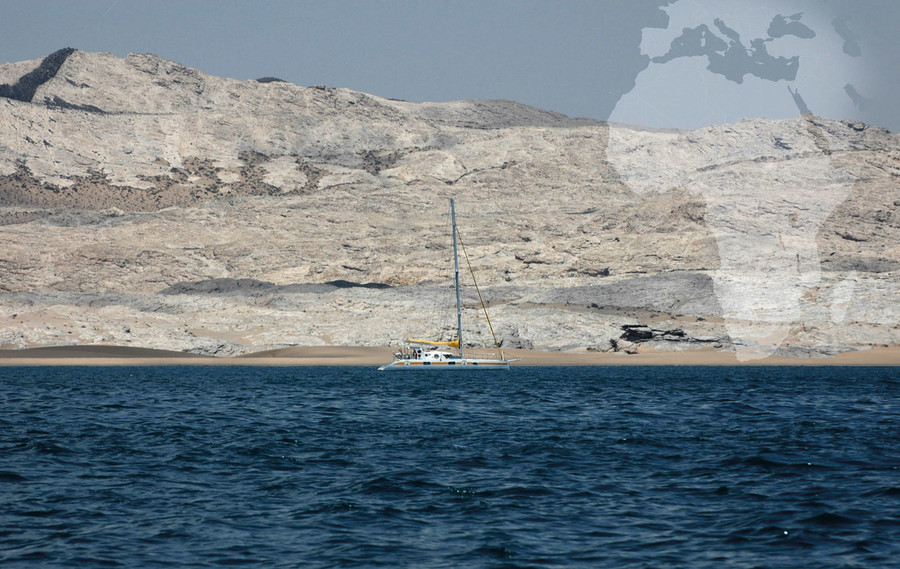
Jangada in her Spencer Bay anchorage off Namibia’s desert coastline…
Escale insolite à Spencer Bay…
An unusual stopover in Spencer Bay... Back on board, we left in a thick fog, with the engines idling, the radar running and the lookout on the bow. I’m quite pleased to be heading out to the open sea again. From time to time, a seal shows us its whiskers by emerging a few meters from the catamaran. The engines are running against the light morning wind, which regularly blows from the north at about ten knots. Usually, this light breeze drops completely around noon, with the first rays of the sun, which will also rapidly increase the visibility to a few hundred meters, then more. About ten miles offshore, we head towards Spencer Bay, where I know I will find a beautiful shipwreck and an island inhabited by thousands of birds: Mercury Island. The coastal scenery is made up of enormous dunes mixed with very old black rocks. Spencer Bay, located about 60 miles north of Lüderitz, is a pleasant anchorage for sailboats. Most sailors prefer to leave Cape Town directly for St. Helena Island, in order to avoid the difficulties of Namibian coastal navigation. What a pity! Our electronic chart was very inaccurate, so we entered the bay at a reduced speed, with one eye focused firmly on the depth sounder. The bottom was even and sandy. The bay was deserted. No one was there. As we entered Spencer Bay, we passed the small beach where a cargo ship had run aground a long time ago. I saw hundreds of seals, a whole colony in fact that had taken up residence near the wreck. Later, I would learn that this was the wreck of the Otavi, a guano transport ship, which had been driven ashore during a storm in 1945, when it had come to Mercury Island to take on bags of the precious material. The island is a good mile away from the anchorage, in the open bay, and is inhabited by thousands of birds. They are mainly cormorants and boobies, as well as many penguins. There is an ornithological station on the island. As we approached, we noticed that each part of the territory of the island, from sea level to the top, is inhabited by different species of birds. The Cape penguins, particularly numerous on Mercury, naturally occupy the lower parts. They can no longer fly and are not particularly fast walkers (on the other hand, they swim very well). Black cormorants, which often fly in squadrons of several dozen individuals, occupy the intermediate zone between the penguins and the boobies. The latter are like large flying machines with an imposing wingspan. Their majestic flight and their marvelous swooping dives in pursuit of the fish they have targeted put them in the top category of Mercury’s small world. They also need more space to take off and land. So they occupy the aristocratic heights of the island. An old wooden dock and a few pulleys still resist the passage of time. This wharf was used to embark the bags of guano collected on the island until the beginning of the 50s.
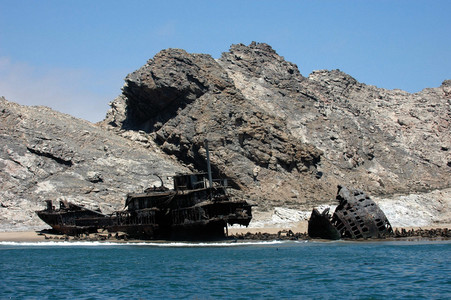 |
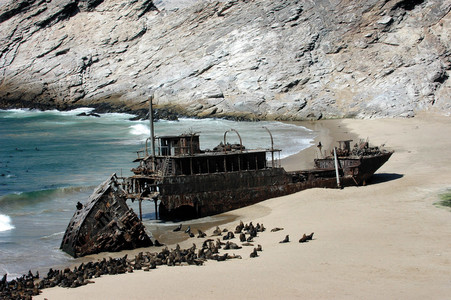 |
The wreck of the small cargo ship Otavi, a guano carrier which ran aground in 1945 on the beach at Dolphin Head.
A Dolphin Head, entre phoques et chacals
Seals and jackals at Dolphin Head We decided to take a closer look at the wreck of the Otavi! We made a rather damp landing in the middle of the waves which were breaking on the immense beach which bordered the mooring. We waited, we observed, and we chose our wave, but we got soaked all the same! We hauled the dinghy high up the beach with its pivoting wheels system. On the sand we noticed a lot of tracks left by the jackals, which patrol tirelessly on the seashore in search of their prey which is made up of carrion, weak or dying animals and fish washed up by the sea. They obviously have their usual routes, and I noticed that as soon as any object stood out from the infinite uniformity of the sand, it had been systematically checked and sniffed out by the jackals, who are used to making do with little to survive. The biggest footprints are those of the brown hyenas, also used to the Namibian seashores, but with more nocturnal habits. It’s ideal for us as we aim to get back to the boat before nightfall! In the distance, mirages appear above the depression of the ground which forms vast salt flats. We climb the ledge on the seaside, the interior passage being the one used by the jackals. When we reach the top, the view suddenly opens up to the magnificent spectacle of the wreck of the Otavi lying on the sand, surrounded by hundreds of fur seals that share the beach with the old iron carcass. On closer inspection, I realize that the seals are not alone. There are also jackals, a good dozen of them, the largest of which harass the seals sunning themselves on the sand, looking for signs of weakness, illness, or impending death. But the seals also have quite long tusks, which the jackals are wary of... We spent some time observing this natural spectacle, which must be repeated every day. The carousel of the jackals is incessant. They have to feed themselves, as they and their young are hungry. And this huge colony of seals, settled at Dolphin Head probably for centuries, is their natural pantry. During the day, they share the bay with the seals. But at night, they have to give way to the more powerful hyenas. Some scenes of predation should not be shown to everyone... I suggest going down the ledge to have a closer look at the wreck, and the animals that surround it. Adélie and her mother, always cautious with wild animals, preferred to stay at their lookout post on the ledge, watching the spectacle. Marin and I walked slowly down into the arena, so as not to scare the colony. Visits are so rare in Spencer Bay... However, by the time we reached the beach, word had got around. The jackals had run away across the small stony plain adjacent to the beach and had then climbed the rocky outcrop. The little freighter had a lot of character, and I would have liked to have visited her when she was in service. The exterior passageways with their fittings almost made me think of a small coastal liner. The smell of her cargo however, must have been very different from that of the fine perfumes... In the bowels of the small ship, sea lions had taken up residence. A little further away, we discovered the colony’s cemetery. Either the dying animals go there by themselves, which I doubt, or more likely the hyenas drag the corpses there for nightly feasts less exposed to the fury of the big males. Marin decided to pull out some tusks from the jaws that had been bleached by the Namib sun. There are dozens of corpses, but most of them have dried out and don’t smell. Some jackals have stopped at the top of the ledge, surprised and outraged by the untimely visit of the two-legged crew of the multihull that has anchored in the bay. They watch us carefully, refusing to abandon their home bay so easily.
In the distance, Jangada pulling gently on her chain, forms the foreground of a grandiose desert setting. A little back from the beach, we discover old hand-operated machines, made of wood and iron, that men had abandoned, as they do everywhere. Time has been at work for decades here, trying to erase man’s legacy, but it will be a very long time before the desert has completely eliminated these vestiges. We returned to the catamaran before nightfall. The jackals had probably already reoccupied the bay where the wreck was situated and will once more be prowling around the seal colony.
The next morning, we left Spencer Bay, in a thick fog of course, heading north, eyes fixed on the radar screen...
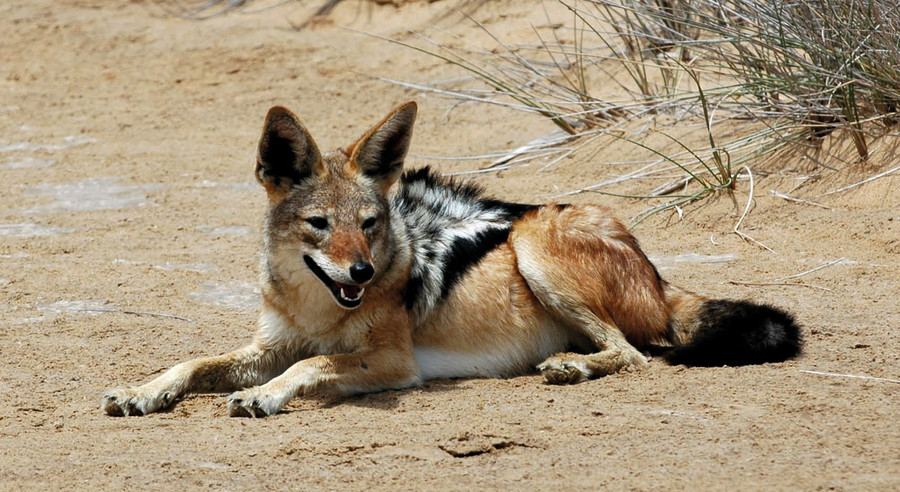
The black-backed jackal, the Namibian coast’s relentless scavenger.
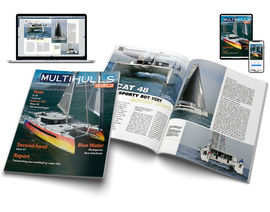
What readers think
Post a comment
No comments to show.